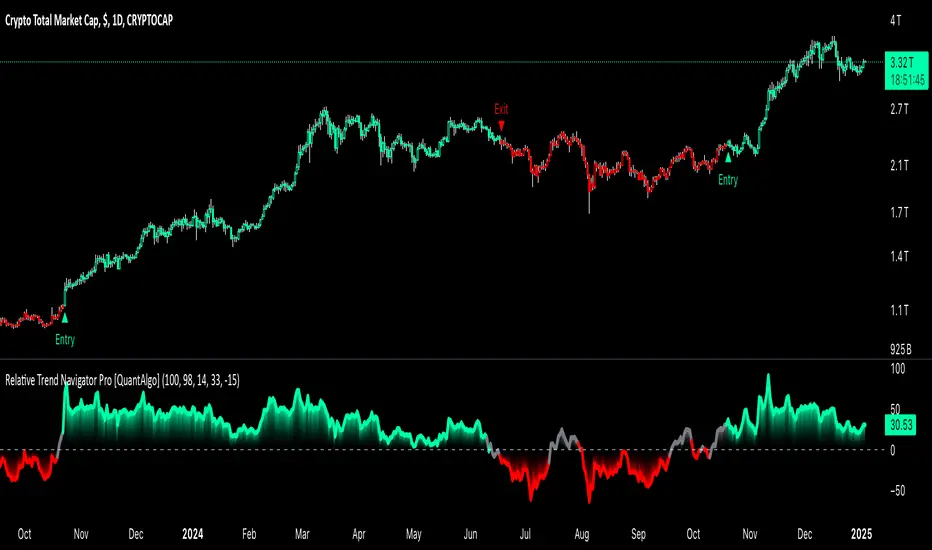Relative Trend Navigator Pro [QuantAlgo]

🟢 Core Architecture
The foundation of this indicator lies in its innovative Relative Trend Index (RTI) calculation and dynamic state management system. By implementing a unique array-based analysis alongside statistical volatility measures, each price movement is evaluated against its historical context while maintaining responsiveness to current market conditions. This sophisticated approach helps distinguish genuine trend developments from market noise across various timeframes and instruments.
🟢 Technical Foundation
Three key components power this indicator are:
- Dynamic Trend Boundaries: Utilizes standard deviation-based channels to establish adaptive price ranges
- Array-Based Historical Analysis: A comprehensive dynamic momentum system that processes and sorts historical data for trend context
- Relative Trend Index (RTI): A normalized calculation that measures current price position relative to historical boundaries
🟢 Key Features & Signals
The Relative Trend Navigator Pro delivers market insights through:
- Color-adaptive RTI line that reflects trend strength and direction
- Dynamic threshold levels for bull and bear signal generation
- Smart fill coloring between RTI and zero line for enhanced visualization
- Clear entry and exit markers for validated trend changes
- Intelligent bar coloring that highlights current trend state
- Customizable alert system for both bullish and bearish setups
🟢 Practical Usage Tips
Here's how to maximize your use of the Relative Trend Navigator Pro:
1/ Setup:
- Add the indicator to your favorites ⭐️
- Begin with the default historical lookback for balanced analysis
- Use the default sensitivity setting for optimal signal generation
- Start with standard threshold levels
- Customize visualization colors to match your chart preferences
- Enable both bar coloring and signal markers for complete visual feedback
2/ Reading Signals:
- Watch for signal markers - they indicate validated trend transitions
- Monitor RTI line color changes for trend direction confirmation
- Observe the fill color between RTI and zero line for trend strength
- Use the built-in alert system to stay informed of potential trend changes
🟢 Pro Tips
- Adjust Historical Lookback Period based on your preferred timeframe:
→ Lower values (20-50) for more responsive signals
→ Higher values (100-200) for more stable trend identification
- Fine-tune Sensitivity based on market conditions:
→ Higher values (95-100) for choppy markets
→ Lower values (85-95) for trending markets
- Optimize Threshold Levels for your strategy:
→ Increase thresholds for stronger trend confirmation
→ Decrease thresholds for earlier entries
- Combine with:
→ Volume analysis for trade confirmation
→ Multiple timeframe analysis for strategic context
→ Support/resistance levels for entry/exit refinement
Script su invito
Solo gli utenti approvati dall'autore possono accedere a questo script. È necessario richiedere e ottenere l'autorizzazione per utilizzarlo. Tale autorizzazione viene solitamente concessa dopo il pagamento. Per ulteriori dettagli, seguire le istruzioni dell'autore riportate di seguito o contattare direttamente QuantAlgo.
TradingView NON consiglia di acquistare o utilizzare uno script a meno che non si abbia piena fiducia nel suo autore e se ne comprenda il funzionamento. È inoltre possibile trovare alternative gratuite e open source nei nostri script della community.
Istruzioni dell'autore
📩 DM if you need any custom-built indicators or strategies.
Declinazione di responsabilità
Script su invito
Solo gli utenti approvati dall'autore possono accedere a questo script. È necessario richiedere e ottenere l'autorizzazione per utilizzarlo. Tale autorizzazione viene solitamente concessa dopo il pagamento. Per ulteriori dettagli, seguire le istruzioni dell'autore riportate di seguito o contattare direttamente QuantAlgo.
TradingView NON consiglia di acquistare o utilizzare uno script a meno che non si abbia piena fiducia nel suo autore e se ne comprenda il funzionamento. È inoltre possibile trovare alternative gratuite e open source nei nostri script della community.
Istruzioni dell'autore
📩 DM if you need any custom-built indicators or strategies.